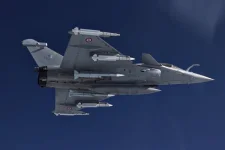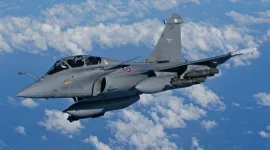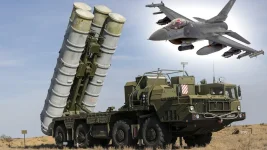India is reportedly considering the acquisition of Russia's advanced Voronezh Over-the-Horizon (OTH) radar system, a move that would place the nation alongside the United States, Russia, and China as operators of such sophisticated technology.
This potential procurement, valued at an estimated $4.5 billion (approximately ₹40,000 crore), could dramatically improve India's strategic defence capabilities.
The proposed radar, possibly located in Chitradurga, Karnataka, is said to offer remarkable detection capabilities, scanning up to 8,000 kilometres vertically and 6,000 kilometres horizontally.
According to reports, obtaining the Voronezh system would give India the ability to detect challenging targets like stealth aircraft, fighter jets, and various ballistic missiles, including long-range ICBMs, launched from neighbouring countries such as China and Pakistan.
This capability would significantly enhance early warning times and overall situational awareness, crucial for monitoring the vast Indian Ocean Region (IOR) and beyond.
Amidst ongoing border tensions and regional security concerns, the Voronezh radar represents a potentially transformative addition to India's defence infrastructure.
Furthermore, the proposal includes plans for 60% of the manufacturing to occur domestically, aligning with the government's "Make in India" policy.
Currently, India relies on ground-based radar systems which inherently face limitations due to the Earth's curvature. This physical constraint restricts how far they can "see" over the horizon, impacting detection range and the time available to react to threats.
For example, the Israeli-made Green Pine radar, part of India's missile defence shield, has a reported range of 500 kilometres. India's domestically developed Swordfish Long-Range Tracking Radar improves on this with a range up to 1,500 kilometres, supporting air defence systems.
However, these radars are primarily designed for threats within a more limited range and may offer very short warning times, potentially only seconds, against targets flying low or appearing suddenly over the horizon.
Over-the-Horizon radars like the Voronezh operate differently to overcome these line-of-sight issues. They transmit high-frequency radio waves that bounce off the ionosphere—an electrically charged layer of the atmosphere starting about 48 kilometres above the Earth. This allows the radar signals to travel over the horizon, detecting objects far beyond the reach of conventional ground-based systems.
Consequently, OTH radars can provide several minutes of warning against ballistic missiles or stealth platforms, a critical advantage.
The Voronezh's capacity to monitor huge areas, including Chinese missile sites near the Line of Actual Control (LAC) and Pakistani missile deployments, makes it strategically vital, particularly following increased tensions since 2020.
Developed by Russia's Almaz-Antey defence corporation, the Voronezh is a modern phased array radar. It operates in different frequency bands to detect various target types: the Voronezh-M uses Very High Frequency (VHF) waves, which are particularly effective against stealth aircraft designed to evade higher frequencies, while the Voronezh-DM uses Ultra High Frequency (UHF) for better resolution in tracking ballistic missiles.
Russian sources highlight its modular, prefabricated construction, which allows for relatively rapid assembly in months, compared to the years required for older radar installations.
With its extensive vertical (8,000 km) and horizontal (6,000 km) reach, the Voronezh system offers coverage comparable to the powerful PAVE PAWS radar network used by the US for missile defence. Russia itself operates a network of eight such radars ensuring comprehensive early warning across its territory.
If installed at Chitradurga, a known aerospace testing hub for India's Defence Research and Development Organisation (DRDO), the radar could survey deep into China and Pakistan, and across the IOR. This would enable early detection of threats like China's anti-ship DF-21D missiles or Pakistan's long-range Shaheen-III missiles long before they approach Indian territory.
The potential acquisition has generated discussion, with observers noting it could provide India a "massive edge" against stealth and missile threats from neighbours. While the $4.5 billion cost is substantial, the combination of its vast range and the 60% local manufacturing component has led some to term it a "strategic steal."
India already possesses capable radar systems, including the aforementioned Green Pine and the advanced Swordfish, whose latest version introduced in 2024 boasts a 1,500 km range and was developed with indigenous technology. These systems are integral to India's Ballistic Missile Defence (BMD) program and have proven effective in tests.
However, the inherent line-of-sight limitations remain a vulnerability against long-range threats, such as hypersonic missiles or missiles equipped with multiple warheads (MIRVs), which both China and Pakistan are developing or possess.
The Voronezh system's OTH capability, particularly its effectiveness against stealth platforms using VHF frequencies, directly addresses concerns regarding advanced aircraft like China’s J-20 and J-35 fighters.
The proposal strongly aligns with India's "Make in India" goals. The planned 60% local production could involve major Indian defence firms like Bharat Electronics Limited (BEL) and Tata Advanced Systems.
Such localisation efforts, common in India's large defence deals, aim to boost domestic manufacturing, create skilled jobs, build indigenous technical expertise, and potentially lower long-term maintenance costs. India's defence budget allocation for capital acquisitions supports such high-value procurements.
Nevertheless, the significant cost presents a hurdle, requiring careful consideration alongside other defence priorities. The deal would likely proceed under a government-to-government agreement, possibly using rupee-rouble trade mechanisms to navigate international sanctions against Russia, although potential risks under policies like the US's CAATSA (Countering America's Adversaries Through Sanctions Act) would need assessment.
Geopolitically, acquiring the Voronezh radar would significantly bolster India's deterrence posture towards China and Pakistan. It would also enhance India's strategic importance within frameworks like the Quad and its ability to contribute to security in the Indo-Pacific.
Its reach across the IOR could aid in monitoring maritime activities, including Chinese naval presence. For Russia, finalising this deal would underscore its longstanding defence partnership with India, potentially involving technology transfer offers to facilitate the agreement.







